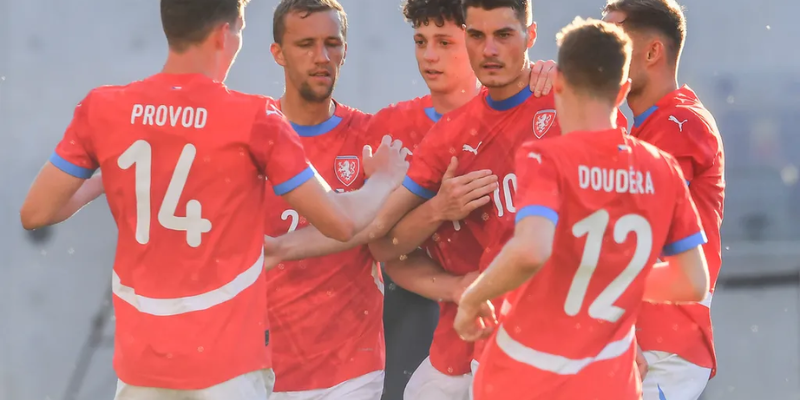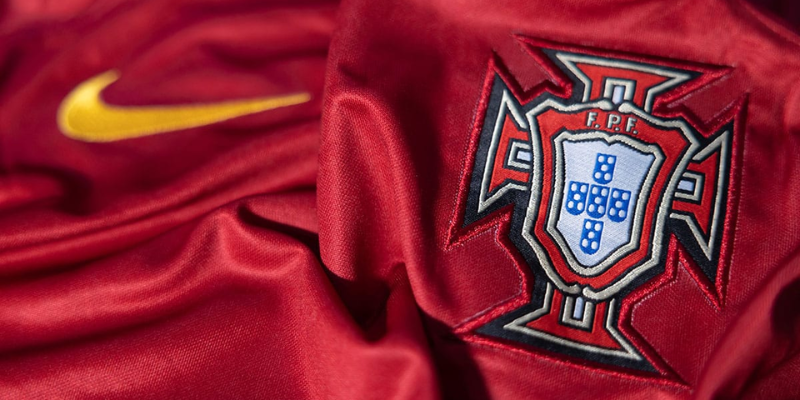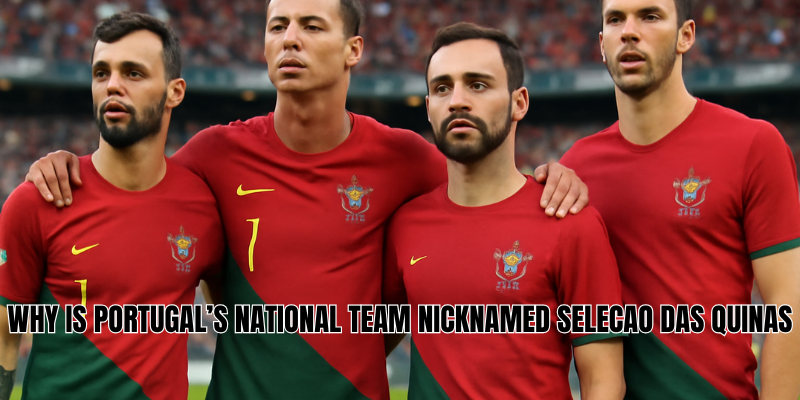From the moment Portuguese fans sing “A Seleção das Quinas”, there’s an electric connection: it’s more than a name — it’s a symbol, history, identity. But why is Portugal’s national team nicknamed Seleção das Quinas? What do “Quinas” mean, and how did this nickname become so central to the Portuguese football identity? In this article, AnaGoal will take you on a journey through heraldry, national symbolism, and football lore to uncover the full story — and show how that nickname continues to resonate across generations of Portuguese fans.
The origin of “Quinas”: history and heraldry

Long before the first football match played by Portugal, the roots of Seleção das Quinas were already embedded in the nation’s history.
What are the quinas?
In Portuguese heraldry, quina refers to each of the five small blue shields (also called escutcheons) that appear in the coat of arms of Portugal. These shields are arranged in a quincunx pattern (one central, four around). The word quina can trace back to the Latin for “five in five,” emphasizing the grouping of five elements.
In the Portuguese coat of arms, these blue shields are charged with silver bezants or “coins,” symbolizing sovereignty, independence, and the historical right to mint currency. Over time, the quinas have become a powerful symbol of Portuguese statehood and identity.
The quinas on the Portuguese national flag and emblem
When Portugal’s state symbolism evolved, the five quinas were incorporated into its flag and national emblem, surrounded by the red border with castles. On the national team’s badge, these quinas remain a central element — five blue shields within the Portuguese crest overlaid on the red and green.
Because the badge is always worn by players during international matches, it naturally became a bridge between the team and national iconography. As fans and commentators alike saw the quinas so prominently, the association between the national side and the “team of the quinas” became inevitable. edia])
How the nickname became popular

It wasn’t at a single moment that Seleção das Quinas was coined — rather, it gradually entrenched itself in culture, media, and fandom.
Historical usage in media and public discourse
Over decades, Portuguese sports outlets, radio commentators, and newspapers began referring to the national team simply as A Seleção (“The Selection”), but with descriptors to distinguish. “Das Quinas” naturally emerged because of the visible shields on the team’s jersey crest. Over time, that descriptor stuck.
Early broadcasts would talk about “the Quinas” as shorthand for the national side, and fans used it with affection. Soon, Seleção das Quinas entered everyday speech among supporters, becoming an accepted nickname globally whenever speaking of Portuguese football.
Cultural resonance and identity
Why did it stick so well? Because it carries emotional weight. The quinas evoke heritage, national sovereignty, and unity. Unlike a nickname tied to a modern icon or gimmick, Seleção das Quinas connects the team to centuries of Portuguese history. As players run out wearing that crest, they carry that symbolism onto the world stage.
Thus it became not only a convenient nickname, but a mantle of pride. As Portugal earned recognition in European and global football, that nickname traveled with them — in broadcasts, on banners, in chants.
The meaning behind the nickname, dissected
Understanding Seleção das Quinas fully means appreciating both words and their emotional implications.
“Seleção” — the national selection
In Portuguese, seleção translates roughly to “selection” — meaning a selected group of players representing the nation. In football terms, A Seleção is shorthand for the Portuguese national team. It implies the best chosen to represent the country, not a club or regional side.
“das Quinas” — of the shields
When we say “das Quinas,” we mean “of the shields”, referencing the quinas (the five blue escutcheons). So the literal translation of Seleção das Quinas is “Selection of the Shields.” Because those shields are so integral to Portugal’s emblem and identity, that phrase carries national symbolism.
Put together, A Seleção das Quinas paints the picture: the national team of the shields, the squad carrying on their chest the emblematic symbols of Portugal itself. It’s not decorative — it’s foundational.
Other nicknames, comparisons, and how Seleção das Quinas fits in
While Seleção das Quinas is the primary and most evocative nickname, the Portugal national team carries others, too.
- A Seleção: A shorter, simpler form. It’s common and widely used in Portuguese to refer to “the national team.”
- Os Navegadores (The Navigators): A less common nickname, referencing Portugal’s age of exploration heritage. Some media use this occasionally, but it has never achieved the iconic status of Seleção das Quinas.
- Lusos: Sometimes used for Portuguese teams or identity (from Lusitania) — but rarely in high-level media when speaking of the senior national team.
Comparatively, many countries adopt nicknames tied to animals (e.g. “Les Bleus,” “Die Mannschaft,” or “La Albiceleste”). Seleção das Quinas stands out because it is derived.
How players, fans, and media embrace the nickname

The nickname is not just a label — it’s a living part of Portugal’s football culture.
Players and the crest
Every Portuguese national team jersey bears the five shields. When a player puts it on, they’re literally wearing the “quinas.” Posters, portraits, and merchandising often highlight those shields with phrases like “das Quinas” to reinforce identity.
Fan culture and chants
You’ll hear chants referencing the quinas in stadiums. Supporters will wave flags that prominently display the full coat of arms with the quinas, and sometimes explicitly write lyrics mentioning “Quinas” or “hino das Quinas.”
In fan art, murals, and social media, the quinas are ubiquitous. The nickname is accepted as a badge of honor among supporters.
Media usage
Commentators, pundits, and even international media frequently refer to Portugal as Seleção das Quinas, especially in tournament coverage, pre-match previews, and historical write-ups. It helps distinguish the Portuguese national side in contexts where “Portugal” alone might be ambiguous.
The nickname also helps anchor keyword usage in digital content about Portuguese football, giving search presence to cultural, historical, and statistical narratives.
Key points summarized
Let’s break down the essentials:
| Element | Explanation |
| Quinas | The five blue shields on Portugal’s coat of arms and national badge |
| “Seleção das Quinas” | Literal: The selection (team) of the shields |
| Origin | Derived from Portugal’s heraldry and national emblem |
| Adoption | Popularized through media, fandom, and matchday imagery |
| Significance | Serves as a bridge between football and national identity |
Because the quinas are so tightly integrated into Portugal’s visual and symbolic identity, the national team could never escape the tie — hence the natural evolution of Seleção das Quinas.
Conclusion
Seleção das Quinas remains a nickname that carries weight, pride, and heritage. In this article, AnaGoal has shown that the name emerges not, but from Portugal’s very symbol — the five quinas — forever linking the national team to the identity of the nation. Whether you hear fans chanting, read a match preview, or see the crest glinting in sunlight, the phrase endures.
If you enjoyed this dive into football symbolism, stick around at AnaGoal. We offer more stories about player legacies, national team histories, transfer news, and top lists that every fan will love. Search for your favorite player or team next — and remember: when Portugal steps onto the pitch, they bring the Seleção das Quinas with them.



